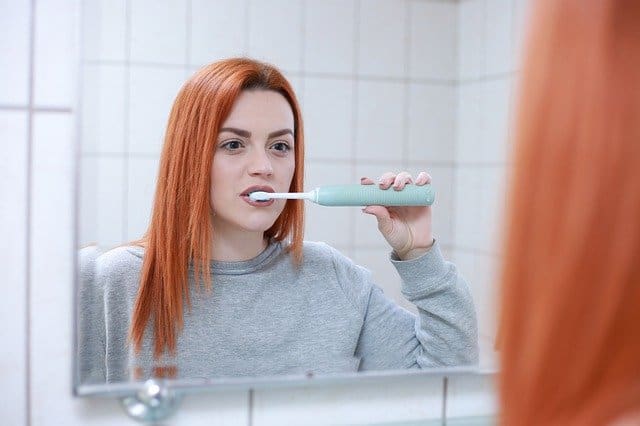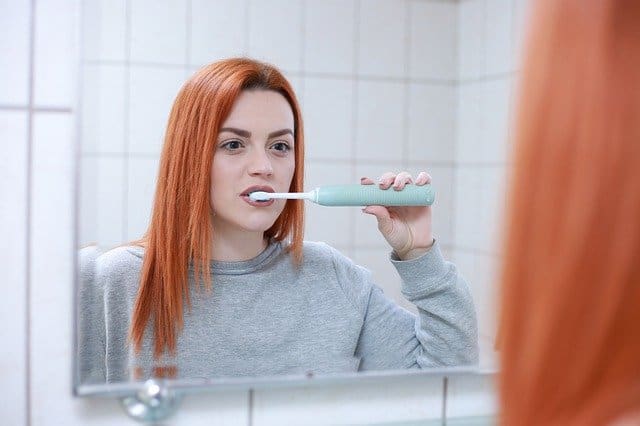Brushing your teeth with braces. Congratulations! With your new braces in place, you are on your way to a beautiful smile that will last a lifetime. But to keep your smile at its healthiest during the time you are undergoing orthodontic treatment, it is important to understand how to properly brush your teeth during treatment with orthodontics. While brackets and wires do present some unique challenges and require some changes to your daily home routine for dental hygiene, these changes are easy to implement and will ultimately result in a beautiful, healthy smile. In this post, we’ll show you the best way of brushing your teeth with braces. Let’s get brushing.

Image by Martin Slavoljubovski from Pixabay
People Also Ask
- How many times do you need to brush your teeth with braces?
- Do you use toothpaste with braces?
- How long does it take to brush your teeth with braces?
- Can you use a normal toothbrush with braces?
People Also Teach
Before Brushing
Good Food Choices
Firstly, make sure you are avoiding foods that aren’t compatible with your treatment, such as chewy or sticky candy, popcorn, and carbonated and sugary beverages. Each of these can cause havoc for your oral hygiene and your teeth, including loosening or breaking off brackets, uncomfortable and unhealthy trapping of food particles like kernels and husks in your gum line, and in your brackets, and an increase in plaque formation on the surfaces and in between your teeth.
Choose Right Tools
Before you begin, make sure you have the right tools to properly clean your teeth. You may find that even eating foods that are safe will leave behind particles stuck in or around your brackets and wires or in your gums. Using special tools such as a rubber-tipped gum massager or an interdental brush to loosen those particles before brushing will help you fully clean your teeth. Rinse your mouth with water to remove those loosened food particles and to prepare your teeth for cleaning.
Can you use a Normal Toothbrush With Braces?
Firstly, you should use the toothbrush recommended by your orthodontist and hygienist for your individual needs and customized treatment plan. Many orthodontists will recommend an electric toothbrush with a spinning brush head during treatment to food particles; there are also sonic toothbrushes on the market. Even if you use a manual toothbrush, be sure to check.
An electric toothbrush is vigorous. Check that the brush head is designed for cleaning your teeth around brackets and wires; manual toothbrushes for orthodontic treatment have V-shaped bristles. With the outer bristles taller than the bristles in the center of the brush. This allows for the longer bristles to reach the surfaces of the tooth on either side of the bracket.
Check the brush head on your toothbrush frequently, whether you use an electric or a manual toothbrush. The bristles on your brush headwear out and become damaged. This happens more quickly due to brushing over and around the metal parts of your brackets. Expect that you will need to replace the brush head of your electric toothbrush or your manual toothbrush as frequently as every two months to maintain consistent cleaning results.
While Brushing
Do you use Toothpaste with Braces?
Firstly, use the toothpaste recommended for your treatment plan by your orthodontist and hygienist. You may have used a whitening toothpaste in the past before your braces were on your teeth. Whitening toothpaste is not recommended during orthodontic treatment.
Because it could create an uneven whitening of the surfaces of the teeth that are exposed as compared to the surfaces of the teeth where the brackets are cemented. Utilize a toothpaste with fluoride designed to fight cavities, and use only a small amount, the size of a pea, on the toothbrush bristles when you brush.
The Right Motion
Brush your teeth by moving the brush head in a small, circular pattern along the surfaces of your teeth. Because your brackets are positioned in the center of your teeth, you will need to brush both above and below the brackets to fully clean your teeth and gums. Tilt the brush head to maximize the contact points between the bristles and the teeth and gums; simply holding the brush head flat or parallel to the surface of the teeth may cause you to miss some areas above and below the brackets.
Use the Right Amount of Time
Brush your teeth for at least two to three minutes after every meal, getting all the surfaces clean along the front, top, and back sides of your upper and lower teeth. Many electric toothbrushes have built-in timers to make this easier; if you prefer a manual toothbrush, be sure to grab a timer or clock to brush for the proper amount of time.
After Brushing
The Right Floss
To avoid the collection of food particles, floss your teeth well using floss designed for orthodontic treatment. You may need to use a floss threader to move the floss behind the wire and into place between your teeth. Floss the surfaces of the sides of each tooth with your floss threader after every meal. Do this by moving the floss gently up and down on both sides of each tooth. Flossing with braces is tricky and you’ll need patience.
The Right Rinse
After brushing your teeth and floss, rinse your mouth out with water then rinse with a fluoride liquid. This helps strengthen and protect your teeth from decay. Some oral rinses may also contain re-mineralizing agents. These can help to deter the harmful effects that acids found in food and drinks and created by bacteria; these acids lead to the breakdown of tooth enamel. Ask your orthodontist or hygienist which oral rinse would be best for your orthodontic treatment plan.
Contact us Today
The team at The Schulhof Center, led by orthodontist Dr. Adam Schulhof, an internationally recognized expert on lingual braces, orthodontic treatment, and a volunteer instructor in lingual orthodontics at the prestigious Columbia University, prides itself on custom treatment for orthodontic correction of even the most difficult cases and empowers their patients through education on best practices for home dental hygiene. Following the simple tips outlined below will keep your teeth and gums healthy during orthodontic treatment.
Conclusion
Keeping your teeth clean with brushing during orthodontic treatment may take a bit more time, planning, and a few extra tools. But the end result of a healthy, straight smile is well worth the extra effort. If you are wondering if orthodontics is right for you, contact the professionals at the Schulhof Center for a consultation. Dr. Schulhof will tailor a treatment plan to meet your specialized needs, no matter what your age or stage of life is. “Contact us today – orthodontics shouldn’t just be a treatment, but an experience!”
Which tip will you try first???
Either way, let us know by leaving a comment below right now and continue the conversation.
New Jersey Office
400 Kinderkamack Rd.
Oradell, NJ 07649
Phone: 551-231-5323
What’s Best for Brushing Your Teeth with Braces (EPIC FACTS)




